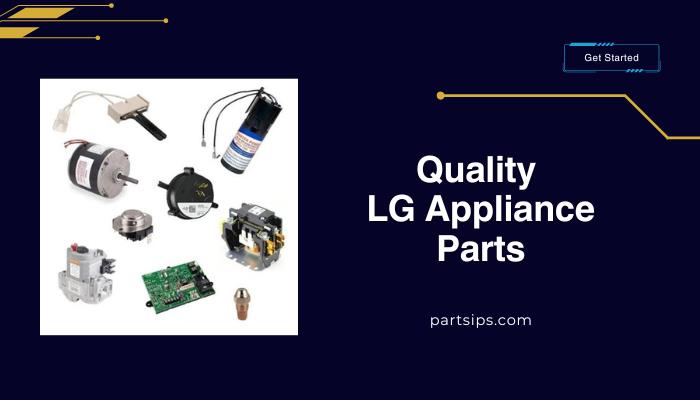Introduction
Home appliances are the backbone of modern convenience—refrigerators keep our food fresh, washing machines handle our laundry, and dishwashers save us time. But like all mechanical systems, appliances can break down, often needing replacement parts to restore them to full functionality. Whether you’re a homeowner, DIY enthusiast, or service technician, understanding appliance parts is essential to keeping your home running smoothly.
In this article, we’ll explore what appliance parts are, the most commonly replaced ones, where to find genuine replacements, and tips on how to maintain your appliances for years to come.
What Are Appliance Parts?
Appliance parts are the individual components that make up larger household machines. These parts range from small electronic elements to large mechanical assemblies. When an appliance stops working properly, it’s often because one of these parts has worn out or failed.
For example:
- Motors power washers and dryers.
- Thermostats regulate oven and refrigerator temperatures.
- Water inlet valves control water flow in dishwashers and washing machines.
- Filters keep air and water clean in refrigerators and air conditioners.
Understanding these parts helps in diagnosing issues and ensuring correct replacements.
Why Do Appliance Parts Fail?
Even the best appliances can fail over time due to:
- Normal wear and tear
- Power surges or electrical faults
- Poor maintenance or overuse
- Low-quality manufacturing
- Improper installation or handling
Timely replacement of faulty parts can extend the life of your appliance and save money compared to buying a new unit.
Top 10 Most Commonly Replaced Appliance Parts
Here’s a list of parts that frequently require replacement:
- Dryer Belts – Worn belts are a common cause of dryers not spinning.
- Refrigerator Water Filters – Need regular replacement for clean water.
- Oven Heating Elements – If your oven isn’t heating evenly, this is often the culprit.
- Dishwasher Spray Arms – Clogged or broken spray arms reduce cleaning effectiveness.
- Washing Machine Drain Pumps – Essential for draining water after the cycle.
- Thermostats – Frequently replaced in fridges and ovens for accurate temperature control.
- Door Gaskets and Seals – Cracked or loose gaskets waste energy.
- Burners and Igniters – Common issues in gas stoves and electric ranges.
- Control Boards – The “brains” of many appliances, controlling cycles and functions.
- Capacitors – Help motors start and run efficiently, especially in HVAC units.
How to Identify the Right Appliance Part
Before purchasing any part, you need to make sure it’s compatible with your appliance model. Here’s how:
- Model Number: Always check the model number on your appliance’s data plate. This ensures compatibility.
- Part Number: If you’re replacing an old part, use the exact part number (usually stamped or labeled).
- Manufacturer Website: Many appliance brands offer parts catalogs online.
- User Manual: Your appliance manual often includes diagrams and part listings.
- Third-Party Retailers: Sites like RepairClinic, AppliancePartsPros, and PartSelect can help match parts to your model.
OEM vs. Aftermarket Parts: Which Should You Choose?
When buying parts, you’ll often have to choose between OEM (Original Equipment Manufacturer) and aftermarket parts.
- OEM Parts: Made by the appliance’s original manufacturer, ensuring perfect fit and performance. Often more expensive.
- Aftermarket Parts: Made by third-party companies, usually more affordable but may vary in quality.
Tip: If the appliance is under warranty, always opt for OEM parts to avoid voiding coverage.
Where to Buy Appliance Parts
Here are some trusted sources to find genuine and quality appliance parts:
- Manufacturer’s Website: Ideal for OEM parts and warranty claims.
- Local Appliance Repair Stores: Personalized help and in-person support.
- Online Marketplaces: Amazon and eBay offer wide selections but ensure you’re buying from reputable sellers.
- Dedicated Appliance Part Retailers: Sites like:
Always compare prices, check return policies, and read reviews before purchasing.
Step-by-Step Guide to Replacing Appliance Parts
Replacing appliance parts doesn’t always require a professional. Here’s a general process to guide you:
- Unplug the Appliance: Safety first! Always disconnect power or water.
- Consult Manual or Guides: Use repair manuals or YouTube tutorials.
- Identify the Faulty Part: Diagnose accurately—don’t replace parts blindly.
- Order the Correct Part: Match by part number and model.
- Install the New Part: Follow step-by-step instructions.
- Test the Appliance: Run a cycle or operation to ensure everything works.
Note: If unsure, always consult a certified appliance repair technician.
Tips to Extend the Life of Your Appliance Parts
Regular maintenance can significantly delay the need for part replacements. Here are some practical tips:
- Clean Filters and Vents Regularly
- Avoid Overloading Washers and Dryers
- Use Surge Protectors for Electronics
- Defrost Refrigerators and Freezers When Needed
- Clean Coils and Condenser Units
- Don’t Slam Doors or Lids
- Schedule Annual Inspections for Major Appliances
When to Repair vs. Replace the Whole Appliance
Sometimes, replacing a part may not be worth the cost or effort. Use the 50% Rule:
If a repair costs more than 50% of the price of a new appliance—and the unit is past half its expected lifespan—consider replacing it.
Here’s a quick lifespan guide:
- Refrigerator: 13–15 years
- Washing Machine: 10–12 years
- Dryer: 10–13 years
- Dishwasher: 9–11 years
- Oven/Range: 13–16 years
- Microwave: 7–9 years
Conclusion
Understanding appliance parts and how they function is a powerful skill for any homeowner. Whether you’re repairing a refrigerator, fixing a faulty dishwasher, or replacing a washing machine belt, knowing how to find and install the right parts saves time, money, and stress.
By investing in quality parts, maintaining your appliances, and learning basic repair techniques, you can extend the life of your appliances and reduce the need for costly replacements. Whether you’re a DIY novice or a seasoned repair professional, the right part can make all the difference.
Also read – Dinning Room

